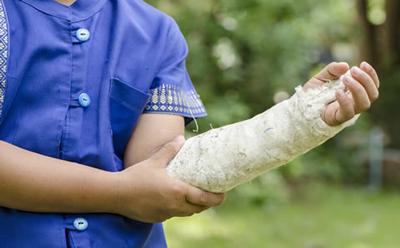Risk of breaking a bone in childhood depends on where you live

The risk of a child breaking a bone can depend upon their ethnicity and where they live in the UK, according to a new Southampton study.
An analysis of the UK Clinical Practice Research Datalink database by researchers at the Medical Research Council (MRC) Lifecourse Epidemiology Unit, University of Southampton, found that rates of broken bones were higher in white children (150 per 10,000 children per year) compared to those amongst South Asian children (81 fractures per 10,000 children per year) and black children (64 fractures per 10,000 children per year).
There were also marked differences in fracture rates according to where children lived, with the highest fracture rates in Wales where children were almost twice as likely to fracture as those living in Greater London. Fracture rates in the North of England and Scotland were also higher than those in the South.
The Southampton team believes the results should help health officials target resources more effectively.
Nicholas Harvey, Professor of Rheumatology and Clinical Epidemiology at the MRC Lifecourse Epidemiology Unit, University of Southampton, led the study with Dr Rebecca Moon, Clinical Research Fellow in Paediatrics.
He said: “Our findings suggest that 30 per cent of boys and 19 per cent of girls will sustain a broken bone before their 18th birthday. However there is no clear indication at this point for why there are these differences in fracture rates. Further work will be needed to understand the reasons for the variation in fracture rates across the UK, but are likely to involve differences in socio-economic circumstances, ethnic diversity, and levels of obesity and physical activity.
“The demonstration of differences in fracture rates by ethnicity and location will clearly be helpful in targeting health resources to those at greatest risk – given the high rates of childhood fracture and the impact in terms of pain, immobility and interruption of schooling, our findings provide real support for such strategies.”
The study, funded by the National Osteoporosis Society and published in the journal Bone, examined the UK Clinical Practice Research Datalink database records covering the period 1988 to 2012. The researchers extracted information on broken bones, and the child’s age, sex, ethnic group and place of residence and calculated the risk of a child experiencing a fracture, and examined whether this risk varied according to age, whether boy or girl, ethnicity and place of residence in the UK.
Fizz Thompson, Clinical and Operations Director at the National Osteoporosis Society, said: “Poor bone health is a massive issue which needs urgent action. More than three million people in the UK are estimated to have osteoporosis and every year people in the UK suffer from 300,000 fractures. This new study carried out by the MRC Lifecourse Epidemiology Unit, University of Southampton, highlights the importance of looking after our bones at a young age and throughout our lives. It also provides useful evidence for developing strategies to target health resources to address fractures, no matter how old we are.”
Cyrus Cooper, Professor of Rheumatology and Director of the MRC Lifecourse Epidemiology Unit, University of Southampton, added: “This study forms part of a larger programme of work addressing risk factors for fracture across the lifecourse, and demonstrates the importance of the University of Southampton and MRC Lifecourse Epidemiology Unit in leading large, UK wide analyses on the internationally leading UK Clinical Practice Research Datalink dataset. These findings will be built upon in a wider programme of analyses to document the burden of osteoporotic fracture in the UK, and will have important messages for public health planning in future years.”